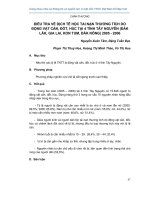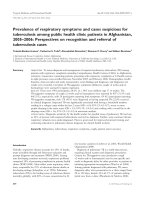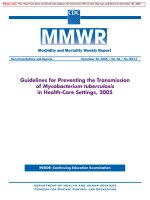2005 week2 basicphysics
Bạn đang xem bản rút gọn của tài liệu. Xem và tải ngay bản đầy đủ của tài liệu tại đây (348.91 KB, 35 trang )
Basic Physical Principles
of MRI
James Voyvodic, Ph.D.
Brain Imaging and Analysis Center
Synopsis of MRI
1) Put subject in big magnetic field
2) Transmit radio waves into subject [2~10 ms]
3) Turn off radio wave transmitter
4) Receive radio waves re-transmitted by subject0
5) Convert measured RF data to image
Many factors contribute to MR
imaging
•
•
•
•
•
Quantum properties of nuclear spins
Radio frequency (RF) excitation properties
Tissue relaxation properties
Magnetic field strength and gradients
Timing of gradients, RF pulses, and signal
detection
What kinds of nuclei can be used
for NMR?
• Nucleus needs to have 2 properties:
– Spin
– charge
• Nuclei are made of protons and neutrons
– Both have spin ½
– Protons have charge
• Pairs of spins tend to cancel, so only atoms with
an odd number of protons or neutrons have spin
– Good MR nuclei are 1H, 13C, 19F, 23Na, 31P
Hydrogen atoms are best for MRI
• Biological tissues are predominantly 12C, 16O, 1H,
and 14N
• Hydrogen atom is the only major species that is
MR sensitive
• Hydrogen is the most abundant atom in the body
• The majority of hydrogen is in water (H2O)
• Essentially all MRI is hydrogen (proton) imaging
Nuclear Magnetic Resonance Visible Nuclei
A Single Proton
There is electric charge
on the surface of the
proton, thus creating a
small current loop and
generating magnetic
moment .
+
+
+
J
The proton also
has mass which
generates an
angular
momentum
J when it is
spinning.
Thus proton “magnet” differs from the magnetic bar in that it
also possesses angular momentum caused by spinning.
Magnetic Moment
B
B
I
L
L
F
F = IBL
Force
W
= IBLW =
IBA
Torque
max
sin
Angular Momentum
J = m=mvr
J
m
v
r
The magnetic moment and angular
momentum are vectors lying along the
spin axis
=J
is the gyromagnetic ratio
is a constant for a given nucleus
How do protons interact with a
magnetic field?
• Moving (spinning) charged particle
generates its own little magnetic field
– Such particles will tend to line up with external
magnetic field lines (think of iron filings
around a magnet)
• Spinning particles with mass have angular
momentum
– Angular momentum resists attempts to change
the spin orientation (think of a gyroscope)
Ref: www.simplyphysics.com
The energy difference between
the two alignment states depends on
the nucleus
E = 2 z Bo
Eh
/2
known as Larmor frequency
/2= 42.57 MHz / Tesla for proton
Resonance frequencies of common nuclei
Note: Resonance at 1.5T = Larmor frequency X 1.5
Electromagnetic Radiation Energy
X-Ray, CT
MRI
MRI uses a combination of Magnetic
and Electromagnetic Fields
• NMR measures the net magnetization of atomic nuclei in the
presence of magnetic fields
• Magnetization can be manipulated by changing the magnetic
field environment (static, gradient, and RF fields)
• Static magnetic fields don’t change (< 0.1 ppm / hr):
The main field is static and (nearly) homogeneous
• RF (radio frequency) fields are electromagnetic fields that
oscillate at radio frequencies (tens of millions of times per
second)
• Gradient magnetic fields change gradually over space and can
change quickly over time (thousands of times per second)
Radio Frequency Fields
• RF electromagnetic fields are used to manipulate the
magnetization of specific types of atoms
• This is because some atomic nuclei are sensitive to
magnetic fields and their magnetic properties are tuned to
particular RF frequencies
• Externally applied RF waves can be transmitted into a
subject to perturb those nuclei
• Perturbed nuclei will generate RF signals at the same
frequency – these can be detected coming out of the
subject
Basic Quantum Mechanics Theory of MR
The Effect of Irradiation to the Spin
System
Lower
Higher
Basic Quantum Mechanics Theory of MR
Spin System After Irradiation
Net magnetization is the
macroscopic measure of many spins
Bo
M
Bo
M c
T
Net magnetization
• Small B0 produces small net magnetization M
• Larger B0 produces larger net magnetization M,
lined up with B0
• Thermal motions try to randomize alignment of
proton magnets
• At room temperature, the population ratio of antiparallel versus parallel protons is roughly 100,000
to 100,006 per Tesla of B0
Quantum vs Classical Physics
One can consider the quantum mechanical
properties of individual nuclei, but to
consider the bulk properties of a whole
object it is more useful to use classical
physics to consider net magnetization
effects.
To measure magnetization we
must perturb it
• We can only measure magnetization perpendicular
to the B0 field
• Need to apply energy to tip protons out of alignment
• Amount of energy needed depends on nucleus and
applied field strength (Larmor frequency)
• The amount of energy added (duration of the RF
pulse at the resonant frequency) determines how far
the net magnetization will be tipped away from the
B0 axis
A Mechanical Analogy: A Swingset
• Person sitting on swing at rest is “aligned” with
externally imposed force field (gravity)
• To get the person up high, you could simply supply
enough force to overcome gravity and lift him (and the
swing) up
– Analogous to forcing M over by turning on a huge
static B1
• The other way is to push back and forth with a tiny
force, synchronously with the natural oscillations of
the swing
– Analogous to using a tiny RF B1 over a period of
time to slowly flip M over
g









